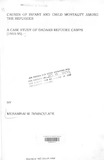| dc.description.abstract | This baseline study set out to investigate the high levels of infant and child mortality in Dadaab camps despite the presence of International Agencies and high levels of International Assistance. Our specific objectives in this study werer-
a. To establish whether there exists any relationship between the standards of living and infant and child mortality.
b. To establish the relationship between cultural beliefs/practices and infant and child mortality.
c. To establish the causes of infant and child mortality.
d. To make recommendations geared towards the reduction of mortality in the camp.
To achieve the above objectives, we established the relationship between household, Community and demographic factors using Jain's (1994) conceptual framework to find out the causes of infant and child mortality among the refugee children.
The data used in this thesis is drawn from a number of sources:- Death registers, hospitals' monthly records, surveys/questionnaire and indepth interviews. The primary and secondary data sources compliment each other in instances of respective insufficiencies. Several limitations were encountered in the course of this study: These include the short period within which the study was carried out, information distortion emerging out oflanguage barrier (in the course of the interviews). This was enhanced by misconceptions, while improper coding and description of the diseases causing death lead to omissions and over-stating of the causes of death hence untallying total deaths between hospital monthly records and the death registers. The methods of analysis were Chi-square test, cross
tabulations, graphical presentations, proportional circles and descriptive statistics'. -_
The study revealed that the major causes of death among the refugee children were mainly from Exogenous causes being 18.7/1000 compared to endogenous causes of 9.3/1000. The major diseases responsible for illness and subsequent death in Dadaab refugee camp were:- Malaria, Diarrhoea, Pneumonia, Neo-natal causes and malnutrition. We also observe that, changes in weather conditions had a bearing on the distribution of diseases that caused death. Our findings indicate that the monthly deaths rates increased with an increase in rainfall and decreased with a decrease in rainfall. The highest deaths were registered during the two peak rainfall seasons namely April, and November, whilst the lowest deaths were in August and January.
The study also demonstrates clearly that unfavourable cultural practices and beliefs impinged on the perception and behaviour of the mother( s). These are transcended through poor hygiene and nutrition hence anaemic and under weight children who were susceptible to diseases. The mothers' inability to use the available health facilities in the camp resulted into inadequate medical coverage for the children who ultimately died from both preventive and curative causes of death due to mother's negligence.
The Chi-square test carried out demonstrates some significant statistical relationships (associations) between illiteracy, place of delivery, place of treatment and infant and child mortality. There is also a significant association between immunisation and the health status of the child. However, the study does not show any significant statistical association between SLP and child death, family size and weight of the child, albeit the statistics (proportions) showed that those women with a low SLI had high childdeaths proportions. That children from a large family of more than 6 peoplehad weight above average compared to those from smaller families of less than 5 people.
The study, further shows that malnutrition is higher in females than males and also in children aged 2-12 months. This is attributed to sex preferences
forboys and secondly, insufficient nutrition for those aged 2-12 months.
I Standard of Living index
AVI
C.A.R.E's'food basket' was rather below the international standard of 2100 calories per person per day albeit acceptable than what other camps were receiving.
Banditry is also cited as an indirect contributory factor to diseases such as gastro-enteritis and other diarrhoeal diseases. This was truly observed in the fear women had in going to the bush to gather wood fuel. Respondents observed that bandits not only raped them, but also violently assaulted them causing other bodily harms. Hence the scarcity of wood fuel for cooking. Consequently children were compelled to eat raw food.
The hijacking of camp operational vehicles by the bandits also jeopardised
I
the smooth running of the camps besides causing panic among the
inhabitants. Otherwise U.N.H.C.R.2continued to provide the essential basic needs/facilities through the N.G.O's3 and these were viewed as 'acceptal levels'(satisfactory).
The study therefore recommended for a thorough system of death registration using appropriate terminologies and descriptions of the diseases causing death. It is argued that this will help generate reliable medical informationon causes of death that would be used for policy
recommendation analysis and evaluation. That M.S.F4. AND C.A.R.E should intensify their activities in the camp through mobile units to alleviate ignoranceand step up coverage. Finally, there was need for a further research in the factors causing the child deaths using advanced demographictechniques | en |

